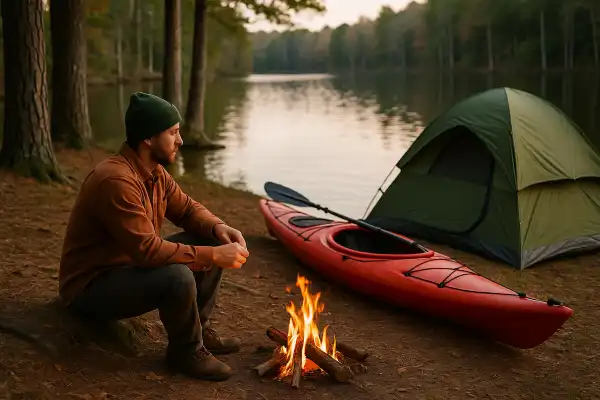Where can you kayak camp in North Carolina remains one of the most frequent questions I receive from paddlers planning their first multi-day adventure. The Tar Heel State offers an incredible diversity of waterways and camping opportunities that can satisfy everyone from beginners seeking gentle lake paddles to experienced paddlers craving remote river expeditions.
During my years guiding trips across North Carolina’s waterways, I’ve discovered that the state’s geography creates unique paddling environments. From the mountainous headwaters of the French Broad to the blackwater swamps of the coastal plain, each region offers distinct kayak camping experiences that showcase different aspects of North Carolina’s natural beauty.
Where can you kayak camp in North Carolina?
North Carolina provides numerous kayak camping opportunities across state parks, national forests, and designated water trails, with options ranging from developed campgrounds accessible by paddle to primitive backcountry sites along remote rivers. The state’s extensive river systems, coastal waterways, and mountain lakes create diverse environments suitable for paddlers of all skill levels.

Mountain region paddle-in camping
French Broad River paddle trail
The French Broad Paddle Trail stands as North Carolina’s premier multi-day kayak camping destination, connecting over 140 miles of river from Rosman to the Tennessee border with strategically placed campgrounds. This trail system allows paddlers to craft expeditions lasting anywhere from one night to a full week.
Private outfitters like Headwaters Outfitters offer guided overnight trips with gear shuttle services, making this an excellent introduction to kayak camping for beginners. The upper sections near Brevard provide gentle flatwater suitable for families, while areas downstream of Asheville feature more challenging Class II and III rapids.
Campgrounds along the trail include both private facilities and primitive sites. The longest single-day paddle distance between camps is 15 miles, from Rhodes Ranch to Buck Shoals campground. Most segments can be completed in 6-8 hours of paddling, allowing time to enjoy fishing, swimming, and exploring historical sites along the riverbanks.
New River State Park
New River State Park offers four paddle-in campgrounds along North Carolina’s section of this ancient waterway, with two sites accessible only by boat. The New River’s Class I and II rapids flow through pastoral farmland and forested valleys, creating an ideal environment for intermediate paddlers.
Each campsite includes tables and grills, with vault toilets available but no running water. The river’s reliable flow and well-maintained access points make it particularly suitable for spring and fall camping when temperatures are comfortable and insect pressure is minimal.
Lake James State Park
Lake James State Park features 30 paddle-in campsites on the Long Arm Peninsula of this 6,812-acre mountain lake. This location provides an excellent base camp for exploring multiple coves and arms of the lake while enjoying stunning Blue Ridge Mountain views.
Sites include fire pits and picnic tables, with vault toilets on-site and a bathhouse accessible by a short paddle. The park rents canoes and kayaks, though availability is limited and advance reservations are recommended.
Coastal region paddle-in camping
Hammocks Beach State Park and Bear Island
Hammocks Beach State Park’s Bear Island offers 14 total campsites, with three sites (spots 12, 13, and 14) accessible only by kayak or canoe. This barrier island camping experience provides pristine beaches and excellent wildlife viewing opportunities.
Campsites operate year-round, though water and bathroom facilities close from mid-November through mid-March. Fires are prohibited on the island, and campers must pack out all trash following Leave No Trace principles. Camping permits must be obtained from the park office before beginning your trip, and overnight parking requires registration to avoid towing.
Masonboro Island Reserve
Masonboro Island, the southernmost uninhabited barrier island in North Carolina, offers primitive camping along its 8.4-mile beach between Wrightsville Beach and Carolina Beach. Access requires launching from Trails End Boat Ramp, Municipal Marina in Carolina Beach, or Wrightsville Beach boat ramp.
Spring and fall provide the best camping conditions due to active bird migration and fewer summer crowds. The island serves as an important research site for salt marsh, maritime forest, and sea turtle nesting habitats.
Piedmont and eastern region options
Merchants Millpond State Park
Merchants Millpond State Park offers a unique paddle-in camping experience through a 760-acre cypress swamp surrounded by Spanish moss and diverse wildlife. Three different paddle-in campgrounds are marked by color-coded buoys: orange buoys lead to the family campground with 10 sites, yellow buoys to a group campground with three sites, and Bennett’s Creek campground located 4.5 miles from the boat ramp with six sites.
All sites provide pit toilets but no other amenities, requiring campers to carry in all supplies and water while packing out trash. The remote Bennett’s Creek location includes both ground-level sites and platform camping.
Roanoke River paddle trail
The Roanoke River Paddle Trail features over 20 unique riverside camping platforms spanning nearly 140 miles of water trail from Weldon to the Albemarle Sound. This vast bottomland hardwood forest ecosystem supports black bear, river otter, deer, bobcat, beaver, and more than 200 bird species.
The river’s historical significance as a colonial trade route adds cultural interest to the natural beauty. Camping platforms provide elevated, dry camping even during high water periods, though campers should check current conditions and platform availability.
Raven Rock State Park
Raven Rock State Park offers six secluded primitive campsites along the Cape Fear River Canoe Trail, plus five group sites accommodating up to 26 people. Sites include pit toilets but require hauling in all supplies and packing out trash.
The Cape Fear River provides opportunities for swimming at the Fish Traps, a unique rock formation, while dense forest and rhododendron thickets create a secluded wilderness experience.
Regulations and planning considerations
North Carolina does not require registration for non-motorized kayaks and canoes, though all vessels must carry Coast Guard-approved personal flotation devices for each person aboard. Children under 13 must wear their PFDs at all times while on the water.
State park camping requires reservations through ReserveAmerica, with a maximum stay of 14 consecutive nights within any 30-day period. Camping is only permitted in designated areas, and fires must be contained in designated fire rings and constantly attended.
North Carolina enforces strict Boating Under the Influence laws, with a legal limit of 0.08% blood alcohol content applying to all watercraft, including kayaks. Additional alcohol restrictions may apply on state park properties.
Seasonal considerations and best practices
Spring and fall generally provide the most comfortable kayak camping conditions in North Carolina. Summer brings higher temperatures, increased insect activity, and crowded waterways, while winter camping requires cold-weather gear and careful attention to hypothermia risks.
Water levels vary significantly throughout the year, particularly on rivers. Check current conditions with park staff or local outfitters before departure. Many coastal sites become inaccessible during storm seasons or high tide periods.
Essential gear for North Carolina kayak camping includes insect protection, sun protection, water purification systems, and appropriate clothing for rapidly changing weather conditions. Tidal charts are essential for coastal camping, while river campers should understand current and flood stage information.
Conclusion
Last October, I guided a family through their first kayak camping trip on the French Broad River, watching their initial nervousness transform into pure joy as we set up camp beside the gentle rapids at Hannah Ford. By morning, they were already planning their next adventure, asking about Lake James and the barrier islands. Following a comprehensive guide like this transforms kayak camping from an intimidating unknown into an accessible adventure. The right preparation and destination choice can turn a single night under the stars into a lifetime passion for exploring North Carolina’s incredible waterways.
